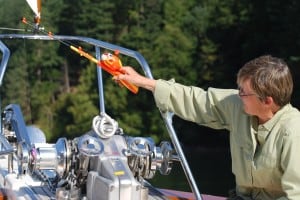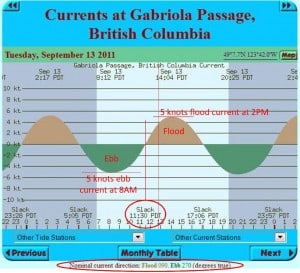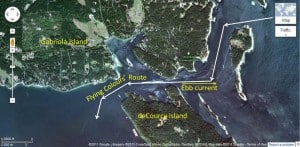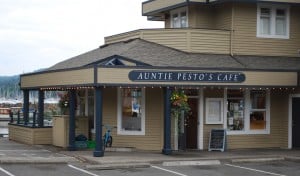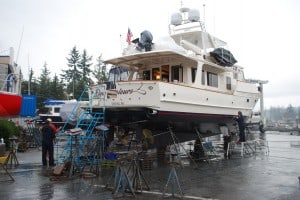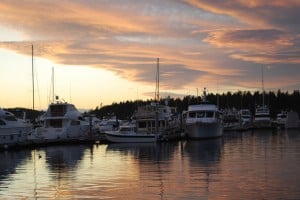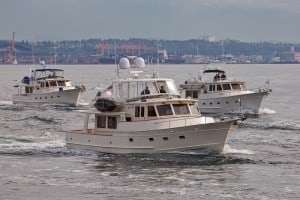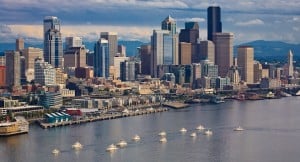
The Fleming Fleet Review passing the Seattle waterfront as the 7th North American West Coast Fleming Rendezvous winds up. Flying Colours is the fifth boat from the lead boat at left. Photo by c-images.
The Fleming Fling at Seattle’s Elliot Bay Marina was the perfect end to our summer on Flying Colours. We arrived in Seattle on Tuesday, September 27th, exactly four months to the day from our Anacortes departure heading north. Granted, we had a tiny amount of at-home time in between, but for the most part, this was our longest cruising summer so far.
Click on any photo to see an enlarged version.
The Fling began the following Friday night and lasted through the weekend. On Monday morning, we then took Flying Colours over to Yacht Masters NW on Lake Union, where a bit of annual maintenance and touch-up will be done, then we’ll take her home to Anacortes for the winter.
But I’m always getting ahead of myself . . .
September 11th, SYC Garden Bay Outstation (Pender Harbour) to Union Steamship Company Marina on Bowen Island
We’ve wanted to visit Bowen Island for some time now, but since it’s located on the east side of the Strait of Georgia and not in our usual cruising line as we head south, it just hasn’t worked out. This time, though, we had almost a full week of cruising left in our schedule before we needed to be in Sidney, and Kap came up with a novel float plan that would take us down the east side of Georgia Strait from Pender Harbour. Then, after visiting Bowen Island the distance across the notoriously rough Strait of Georgia, altogether bypassing Nanaimo and Dodd Narrows proved interesting. I was all in favor of it.
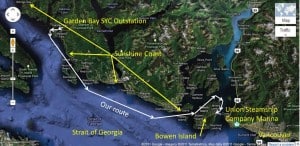
Our route from the Seattle Yacht Club Garden Bay Outstation to the Union Steamship Company Marina on Bowen Island.
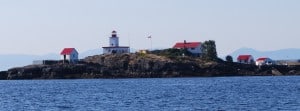
Merry Island Lightstation in the Strait of Georgia is three miles south of Halfmoon Bay. The lightstations (we call them lighthouses in the U.S.) on the B.C. coast are almost always scenic, and while nothing special, this one was no exception.
Our route southward from Pender Harbour followed an area that’s known as the Sunshine Coast – a rugged 53 mile section of the B.C. mainland coast that stretches from Vancouver in the south, to Lund (almost to Desolation Sound) in the north. Much of it is rugged coastline, and while it’s quite heavily populated, a good portion of it is accessible only by B.C. Ferry or floatplane. The Sunshine Coast Highway runs along it, linking many of the towns between the B.C. Ferry port of Langdale in the south (the B.C. Ferry route is from Horseshoe Bay in West Vancouver), to Lund.
For us, the most interesting part of the route was from Secret Cove to Sechelt, passing through a narrow stretch of water between Thormanby Island and the mainland. This is the area of the Smuggler Cove Marine Provincial Park, and it’s very scenic. There are lots of anchorages in this area, and we cruised this part at 7 knots to reduce our wake.
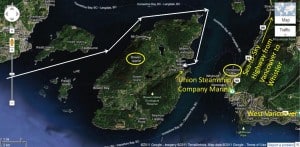
Our route took us around the west side of Bowen Island to the Union Steamship Company Marina in Snug Cove on the NE side of the island.
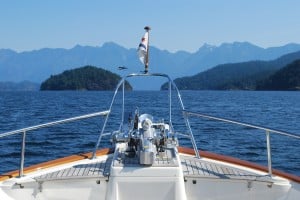
Cruising in calm waters along the west side of Bowen Island. The towering mountains in the background are directly north of Vancouver. Whistler and Blackcomb Mountains are in this range, but 30-40 miles to the north.
Near Eliphinstone at the south end of the Sunshine Coast, Kap’s plotted route took us north along the west side of Bowen Island – the shortest route to our destination deep inside Snug Cove on the NE side of the island. The biggest shock to us along this route was the density of small pleasure boats. It was a Sunday afternoon, and we figured that every marina in Vancouver had emptied out and everyone was out for their weekend high-speed fix on the water. The drivers were crazy, and it soon made us wonder if we’d made a good choice for our next port.
We had a two night moorage reservation at the Union Steamship Company Marina – the largest marina on Bowen Island. It’s named after the company that used to operate Bowen Island as a holiday resort until the mid-20th Century, and during a later afternoon walk around the area we learned just how much of a holiday resort this place must have been a century ago. Accessible by ferries operated by the Union Steamship Company, excursionists from Vancouver flocked here by the thousands to relax and stroll the island. Now, the island has largely become an artist’s colony, and while there isn’t much in the way of downtown shops, there are plenty of art galleries.
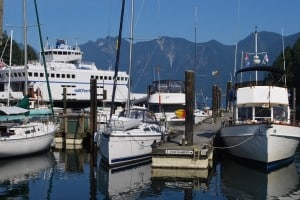
Our moorage was at the end of D Dock with a side tie, looking directly towards the ferry terminal several docks away, with the mountains north of Vancouver in the distance.
As we neared the marina, we called them on VHF channel 66A and were directed to a side tie on the end of D dock. As Kap started into the narrow bay, an AIS marker on our chart plotter showed a B.C. Ferry on approach and he’d have right-of-way. Knowing that we might have to dither while sorting out exactly where we needed to go, Kap quickly spun a 180 outside the entrance to give the ferry room to maneuver. Of course, a bunch of the weekend boaters took that opportunity to jump the queue on us, causing the ferry captain to give out several loud blasts on his horn to get them out of the way.
Finally it was our turn, and we headed deep into the bay to Dock D. Our maneuvering width between the end of the dock and the shore was barely 1½ boat lengths, but Kap expertly turned us on a dime with forward/reverse engines and we gently drifted onto the dock. A friendly young guy was there to catch our lines, and give us a welcome to the marina. After getting Flying Colours secured and shore power hooked up, I walked over to the marina office in a float building at the head of the dock.
As I was checking in, the young woman behind the desk said, “I see you’re prepared for the Seattle Yacht Club discount.” Puzzled, I told her I had no idea what she was talking about.
“Well, with an SYC hat and an SYC polo shirt on, it’s obvious you wanted to make sure we recognized you were from the Seattle Yacht Club. You’re aware, of course, that the marina owners, Rondy and Dorothy Dike, are Seattle Yacht Club members, and they give a 25% discount to all SYC members who moor here?” I had to admit that I wasn’t aware of this, but since two night’s moorage for a 62′ boat is a significant chunk of change, I was certainly glad I accidentally happened to be wearing the SYC logo clothing.
After settling in and giving ZuZu her “getting here” treats, we headed for shore and a walk around the small village to check out our restaurant and grocery store options for the next couple of days. It was finally starting to feel like summer, and even in a lightweight polo shirt and shorts, it was hotter than I like it. We soon came back to Flying Colours for an early happy hour.
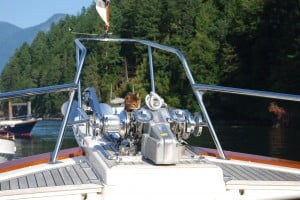
For some reason, ZuZu is always fascinated by all the machinery associated with the windlass. We find her scrounging around here all the time whenever she's on the forward bow.
For dinner, we settled on an Italian restaurant just up the street from the marina, the Tuscany Wood Oven Pizza Restaurant – and it was excellent.
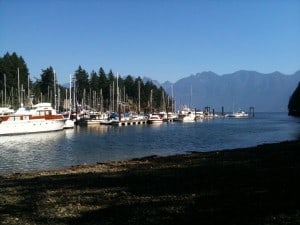
Snug Cove is a very narrow bay, and with the marina docks jutting out into it, there's barely room to turn around. Flying Colours is to the right of center.
Other than that, there really wasn’t much to do. The island is 8 miles long by 4 miles wide, but being quite hilly – and being on foot – getting beyond the tiny village at Snug Cove is difficult.
Nevertheless, this gave us a really good reason to hang around Flying Colours, relaxing on the deck and taking life easy.
All too soon it was time to leave, and after checking the weather Kap decided we needed to be out on the water shortly after first light. The winds come up by midday on the Strait of Georgia, kicking up wind waves that aren’t pleasant, so the earlier start you can get, the better. Besides, our route was through Gabriola Passage – located at the southern end of Gabriola Island and the northern tip of Galiano Island – where the tidal currents can run at 6 knots. We needed to hit it at slack water.
September 13th, Union Steamship Company Marina on Bowen Island to Ganges Marina on Saltspring Island
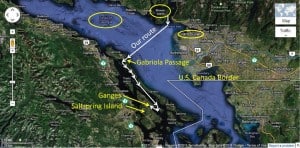
Our route took us southwestward across a bumpy 14 mile stretch of the Strait of Georgia, timed so that we'd reach Gabriola Passage at slack.
Sure enough, we barely turned the southern tip of Bowen Island and into the Strait of Georgia when we hit the wind waves. The wind was coming from the south, causing the waves to build at a fairly uncomfortable angle off our port bow. We could have zigzagged across the 14 mile width of the Strait to give us a better angle with the waves, but it would have significantly increased our crossing time, and the risk was that we’d then miss slack tide at Gabriola Passage. Our ZuZu Rough-O-Meter wasn’t going off, so we pressed on and put up with it.
Kap perfectly timed our arrival at Gabriola Passage! As you can see from the current chart at left, slack at that location is calculated to be at 11:30AM Pacific Daylight Time. We actually arrived at 11:10, and talked over whether we should hang around for 20 minutes, but Kap decided to stick a toe in to see what it was like. Unlike Dodd Narrows on the west side of Gabriola Island, there wasn’t a pack of boats waiting to go through. As Kap rounded the first corner at the entrance, we spied a Grand Banks coming through from the other direction – and that’s always a comforting sign – but other than that, we had the passage all to ourselves.
The passage itself is an S-turn, with the Strait of Georgia on both sides as you cruise southward in a wide channel between Valdez Island and de Courcy Island.
We continued south along the east side of Thetis Island, past a favorite anchorage at Wallace Island, then Montague Harbour at the southern end of Galiano Island. At the SE tip of Saltspring Island we turned around the point at Long Harbour and into the very long Ganges Harbour. We were comfortably tied up at the Ganges Marina dock by 2PM.
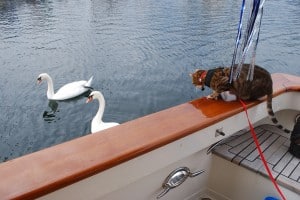
ZuZu often has outsized ambitions - this time she thinks two swans who came by for a handout would make a good snack. When they see her, they hiss their displeasure, and I think they'd actually try to fight her if she leaned over too close - and I don't think ZuZu would come out the winner.
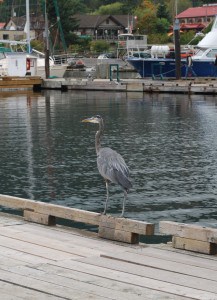
Gator too had eyes bigger than he should - thinking he could take on the prehistoric-looking blue heron who seemed to like our dock.
With Kap’s concurrence, I had a bit of ulterior motive for our stop in Ganges – the Auntie Pesto’s Cafe was calling to me, and I was in the mood for a fix. They serve an absolutely perfect Beef Carpaccio – ultra-thin sliced raw filet mignon, with shaved parmesan cheese, capers, and olive oil drizzled over it. For a main, they make one of the best Spaghetti Carbonara dishes in North America (and yes, Paula, theirs is made with cream).
September 15th, Ganges Marina to Sidney, B.C. on Vancouver Island
After a two day stay in Ganges, it was time to head for Sidney. We had a bit of repair work on Flying Colours scheduled at Delta Marine the following Monday, and we wanted to get into town in plenty of time so that weather problems wouldn’t delay us.
The cruise from Ganges to Sidney is barely two hours, so we got a leisurely start, arriving around midday. Steve and Shirley from the Couverden had been kind enough to let us use their slip at the Port Sidney Marina over the weekend, and that allowed us easy access to town to get some shopping done and a car rented. It also made it easy to have dinner at our favorite schnitzel restaurant, the Suisse Bistro in downtown Sidney (do you get the idea that food plays a role in our cruising schedule?).
On Sunday afternoon, we took Flying Colours over to Delta Marine, deep inside Shoal Harbour to the north of Sidney. Our Fleming guy there, Brian Coverely, had given us access to a boat house where we could have the work done on Flying Colours without weather concerns. We’ve never put Flying Colours into a boat house before, and we didn’t know if we’d fit through the door without having to put our antenna arch down, so there was some trepidation to this move. As it turned out, there were no problems, and an added benefit was that it gave us more security with ZuZu – she could get off the boat anytime she pleased, but with the pedestrian door closed at the dock side, there wasn’t anywhere she could go.
Monday morning, the work began on Flying Colours. The garfed-up porthole cover that we’d damaged in Nanaimo at the beginning of the summer was the first priority, but we also needed annual service on the WhisperGen and the watermaker. At midday, Kap drove me down to Victoria where I caught a Kenmore Air Flight to Seattle. Gator was with me on my lap, and part of my task was to deliver him to Camp Kelly where he’d spend the next couple of weeks with Raz. I also needed to check in on the new house construction. It was a quick trip – I’d return on Wednesday afternoon. Meanwhile, Kap and ZuZu would spend their time on Flying Colours, keeping an eye on the work being done.
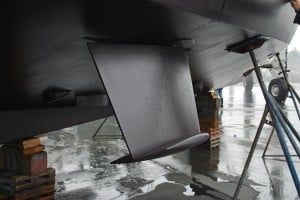
The computerized stabilizer wings on the hull were in great shape. With the gyro/computer that controls these, the stability of the boat is head and shoulders above our previous Nordic Tug.
To my surprise, when I called Kap while I was home, she told me Flying Colours was being hauled out and put on the hard for the next several days. The primary reason was, she wanted to have the propeller shaft and bearings checked to ensure there wasn’t any damage from the line wrap we’d done a month earlier. While doing that, they might as well change the zincs, clean and apply new bottom paint, clean the props, and other general maintenance that’s needed for a boat living in salt water. When I returned, our next few days were spent living on Flying Colours high and dry.
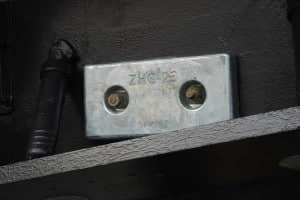
Here's an example of a zinc - basically a slab of zinc that's considered "sacrificial", meaning that it gets eaten up by any stray ungrounded electrical signals around the marinas we're in, from nearby boats that don't have a good ground and are leaking electricity into the water. If we didn't keep our zincs up to snuff, any metal parts on our boat would get eaten up instead.
It took three days to complete all the tasks, as typical with a boat, the initial list of tasks just grew and grew. By Friday, everything was complete, and Flying Colours was ready to be put back in the water.
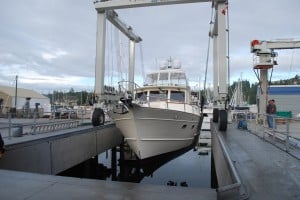
Flying Colours is lowered to the water by a moving crane called a TraveLift. It always amazes me that something weighing 70,000 lbs can be picked up like this and moved around.
The plan was to move Flying Colours back to the boat house for two nights, where she’d be cleaned inside and out the next day.
As the Delta Marine crew got the TraveLift ready to go, Kap quietly told me she’d prefer to have someone from Delta Marina move Flying Colours from the very tight haul-out dock over to the boat house. We asked Brian Coverely to do it, and he readily agreed.
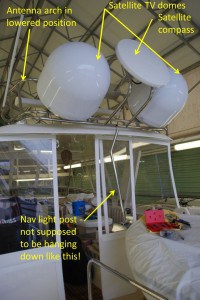
The navigation light post looks pretty sad broken off at its connection point with the satellite arch frame.
All went well, until we got to the boat house. On the way over, I lowered the two 16′ VHF antennas that we knew wouldn’t clear the door of the boat house, but we left the main antenna arch in place – as we’d just been in this boat house three days earlier and everything fit. Brian was driving from the covered fly bridge, and Kap and I were down on the main deck to give a hand on the tight side-by-side door clearance, and to handle the lines. As we moved halfway into the boat house, there was a horrific crash and we felt Flying Colours shudder. Brian hollered something profane from the fly bridge.
It took about two seconds to figure out what happened. There had been another boat in the boat house the day before, and the Delta Marine worker who took it out had raised the folding door – but had stopped raising it about 5″ before he should have. That was enough to hit our navigation light post jutting up from the arch – and was the highest point on the arch. Who would have thought? We’d just been in there three days before, and with a 20′ clearance on the door, who would notice that the door was down 5″ from where it should be.
“No problem,” said Brian. “We’ll have this fixed in no time.”
We could tell he was muttering under his breath at this embarrassing situation, and we knew he was going to have some words with the yard guy who screwed up on the door. As it turned out, it took a full day to complete the repair (at Delta Marine’s cost), and it wasn’t until Sunday before we were ready to depart. In the meantime, Flying Colours got a great exterior wash, interior clean, and rugs cleaned, so she’d be spotless for the upcoming Fleming Rendezvous in Seattle.
September 24th, Sidney, B.C. to Roche Harbor on San Juan Island, WA
Crossing from Canada into the U.S. is always the definitive sign that the cruising season is coming to an end. This time, though, we planned a few days at Roche Harbor on San Juan Island, then down to Seattle for the upcoming Fleming Fling Rendezvous at Elliot Bay Marina.
As we were getting ready to depart, a text message from Jim and Paula on Apt. 5 arrived on my cell phone – “Hey, you guys, where are you?” After texting back and forth, it was decided they would come over to Roche Harbor to meet up with us for a couple of days. They did, and we had a great time catching up on the summer’s activities, two wonderful on-board dinners – one that Paula and Jim cooked, and one that Kap and I cooked. Both evenings were spent playing Wise and Otherwise, a board game that we played almost every night during our bareboat cruises in New Zealand and Australia in 2003 and 2005.
September 27th, Roche Harbor on San Juan Island to Elliot Bay Marina, Seattle
The cruise down to Seattle was uneventful. After hours and hours of weather watching, Kap elected to set our course around the east side of San Juan Island, past Friday Harbor, and through the narrow inlet that separates San Juan Island and Lopez Island. This empties into the Strait of Juan de Fuca at its NE corner, following along the west side of Whidbey Island. We then turned a bit eastward at Port Townsend where it changes to Admiralty Inlet.
As we were nearing the south end of Whidbey Island, we started hearing a very interesting VHF radio exchange. We always have our VHF radios on scan mode, scanning for any transmissions on about six frequencies. One is the local “Traffic” frequency – the equivalent to Air Traffic Control that communicates with airplanes flying in controlled airspace. We do this so we’ll know about commercial traffic that we might be encountering, including freighters, container ships, oil tankers, tug and tows . . . you name it.
This time, a huge Hapag-Lloyd container ship named the Hamburg Express that had just passed us at 21 knots called Seattle Traffic, “Traffic, Hamburg Express, can you give me the frequency to contact the Coast Guard “Little boat” – they’ve indicated they plan to board us, and we need to coordinate how this will occur.” The “little boat” he was referring to is one of the 3-man inflatables the Coast Guard uses, launching from a larger Coast Guard cutter in most cases. We couldn’t see any Coast Guard boats anywhere around us.
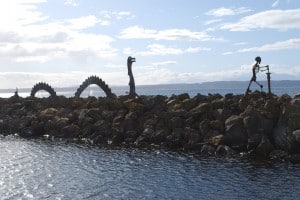
On arrival in Seattle, we stopped off at Shilshole Bay Marina to fuel up. The marina breakwater has these wonderful metal sculpture figures that brings a smile to our face each time we see them.
We perked up at that, as the Hamburg Express was just 1/2 mile in front of us, and it might be interesting to see this going on. Traffic came back with a frequency, and we could hear the freighter calling and calling – but no answer. He called Traffic again, saying that he really needed to talk with them, as if they wanted to board him he’d need to slow down, and doing that quickly isn’t possible. Somehow they got in touch with the “little boat”, and we could only hear their side of the conversation. Presumably to questions from the Coast Guard, the freighter skipper responded that he didn’t have any hazardous or illegal cargo on board, and he gave them a rundown of the crew members on board. The Coast Guard told them to slow to 6 knots (we were doing 10 knots), and after asking about the crew on board, they were told to have two crew in the pilot house, two in the engine room, one down at the boarding platform at the water – and to have the rest of the crew “standing at the main deck railing, passports in hand.” We didn’t hear anything further for about a half hour, and we were slowly closing in on the Hamburg Express. Then we spotted a Coast Guard cutter heading north past us at high speed, presumably with the boarding completed, and the little boat back on board. The freighter resumed speed, and we could see it in the Seattle harbor when we arrived.
October 1-3, Fleming Fling Rendezvous
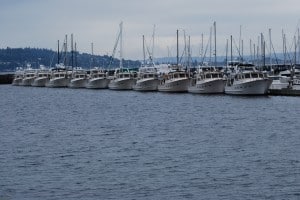
Do you call this a bevy of Flemings? Flying Colours is the last boat at left, and we had the best view of the Seattle skyline across Elliot Bay.
The weekend long Fleming Fling was a lot of fun. By Friday night, 17 Fleming yachts had arrived at the main guest dock at the Elliot Bay Marina, and it was a hoot to see all them in a single file line.
It began with a cocktail party on Friday night, hosted by Chuck Hovey Yacht Sales, the broker for Flemings on the U.S. West Coast. There were upwards of 80 people in attendance, and we were wined and dined like royalty, and entertained by the famed Roosevelt High School Jazz Band.
Saturday morning was a series of seminars on various aspects of operating and maintaining our Flemings. In the afternoon there was an Open Boat, where everyone could shuttle around to visit other Flemings, to see all the new gadgets on newer boats, and to see how others had outfitted and decorated. Saturday night was a fancy sit-down dinner at the Palisades Restaurant that overlooks Elliot Bay Marina.
Sunday morning, following a brunch and a captain’s briefing, was the pièce de résistance – a parade of all the Flemings around Elliot Bay, past the Seattle waterfront, where a helicopter with a professional photographer on board met up and took dozens of photos.
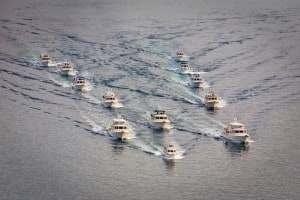
After passing the Seattle waterfront in formation, we were instructed via radio to speed up to 9 knots - presumably to create an interesting wake behind each boat. Photo c-images.
On Monday, October 4th, Kap and I took Flying Colours through the Ballard Locks and delivered her to Yacht Masters Northwest on Lake Unionfor about a month of work to get her ready for next summer’s cruising season. Hopefully, we’ll be able to move her back to the permanent covered slip in Anacortes in early November, where she’ll be out of the long winter’s rain and snow.
All in all, it was a wonderful cruising summer – even if it did end. I hope everyone has enjoyed the blog postings this summer.

